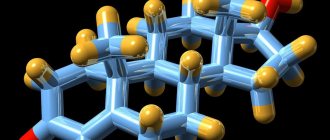Convulsions and laryngospasm are the first symptoms of hypocalcemia; the acute form is dangerous because it develops due to rickets, chronic renal failure, where the main symptom is increased excitability in the neuromuscular system. Below in the article you will find the causes of the disease; the doctors who treat him; necessary medical procedures for treatment; as well as general information about the disease, its localization, features of diagnosis of diseases and their treatment. However, we advise you to consult a doctor, because self-medication is 90% fraught with complications
Make an appointment and consultation
Hypocalcemia. general information
Hypocalcemia is a disease in which the level of calcium in the blood drops below normal. The disease can be acute or chronic. Hypocalcemia in children is usually diagnosed at birth.
When treating hypocalcemia, doctors at the BIOSS clinic use both time-tested and the latest developments and proprietary techniques.
Our clinic employs the best doctors in Moscow who have extensive experience in the treatment of hypocalcemia
Causes
The main causes of hypercalcemia are excess parathyroid hormone in the body (hyperparathyroidism), oncology and long-term use of calcium supplements. Hypocalcemia almost always develops against the background of parathyroid hormone deficiency, the production of which is responsible for the upper and lower parathyroid glands. By interacting with the hormone calcitonin (thyroid), the exchange of phosphorus and calcium in the body is regulated. Excess calcium, as well as deficiency, develops with deviations in the functioning of organs and systems.
WHEN YOU SHOULD SOUND THE ALARM, THE FIRST SYMPTOMS OF HYPOCALCEMIA
The most dangerous form of hypocalcemia is acute, because it has its own characteristics. The first symptom is massive cytolysis. This can happen if the patient has hepatosis, hemolysis, in cases of use of cytostatics, severe burns, traumatic shock and crush syndrome. Because of this, calcium begins to quickly be removed from the blood. Hypocalcemia quickly begins to develop if renal failure is also observed during cytolysis.
The symptoms of hypocalcemia are very different, they lead to various complications - the appearance of arrhythmia and seizures when the disease is severe. The acute form does not have many symptoms, if it is treated in time, it will go away.
The chronic form of hypocalcemia is considered pronounced, because it develops due to rickets, hypomagnesemia, chronic renal failure, and hypoparathyroidism. The main symptom is increased excitability in the neuromuscular system and tetany, which is characterized by peripheral and perioral paresthesia, carpopedal spasm.
Mild symptoms of hypocalcemia may progress to bronchospasm, convulsions, and laryngospasm.
Often chronic hypocalcemia is characterized by neuromuscular and neurological symptoms; patients experience spasms in the muscles of the hands, feet, face, and larynx; convulsions and psychosis may appear; the patient is constantly depressed, very irritable, and stops breathing.
Symptoms
The first signs of hypercalcemia may not be noticeable, and only a random blood test will indicate problems. The appearance of obvious symptoms of increased calcium in the blood depends on the duration of this condition, the rate of development, and the severity of the underlying disease. These symptoms manifest themselves in the main systems of the body: nervous, muscular, digestive, urinary, cardiovascular, eye and skin diseases. The patient's memory deteriorates, lethargy, drowsiness, depression, weakness and muscle pain, restless leg syndrome at night, loss of appetite, constipation, nausea, gag reflex and belching appear. Possible weight loss due to pancreatitis, cholelithiasis, stomach ulcers with high acidity. Arthritis, arthrosis, and gout develop. Hypocalcemia is often combined with a lack of potassium, which leads to excessive excitability of neurons. As a result, muscle spasms occur (shoulders, hands, larynx, facial muscles). Skin sensitivity is also impaired, and a burning sensation or numbness occurs. Hemorrhagic syndrome develops, which is manifested by increased bleeding. Blood clotting decreases. Dystrophic changes in tissues, dental defects, brittle nails, dull hair, dry skin occur, heart rhythm is often disturbed, and cataracts develop.
TREATMENT OF HYPOCALCIEMIA
Be sure to take vitamin D and medications that contain calcium. If hypocalcemia develops due to hypoparathyroidism, it must be treated urgently.
If the patient does not have problems with calcium absorption in the small intestine, then with the help of calcium supplements the disease can be cured in a short time. In cases of acute disease, intravenous administration of chloride, calcium gluconate and gluceptate may be necessary.
To do this, up to 200 mg of calcium is administered over several minutes. It must be remembered that calcium can irritate the venous walls, so it is best administered through a central venous catheter or into a large vein. Treatment must be prescribed by an endocrinologist after a thorough examination.
So, hypocalcemia is diagnosed when the blood level is less than 2.2 mmol/l. Most often, this disease occurs due to metabolic disorders, due to diseases when a person loses calcium through urine. Symptoms may not develop immediately, so it is very important to identify hypocalcemia at an early stage and begin timely treatment.
Treatment
The initial stage of hypercalcemia, which is caused by excessive consumption of foods and medications containing calcium, can help solve the problem of a slight increase in the amount of calcium in the human body: changing the diet towards reducing the amount of foods containing large amounts of calcium. Dose adjustment, replacement or refusal of medications containing calcium. For healthy kidneys, sufficient consumption of water, preferably distilled (no more than 2 months). If hypercalcemia develops against the background of serious illnesses, then treatment is aimed at the underlying disease and cleansing the body of excess calcium. When the kidneys are functioning normally, calcium is usually washed out with the help of diuretics and intravenous saline. In severe conditions, hemodialysis is performed (cleansing the blood of waste products). If the process of increased removal of calcium from the bones cannot be stopped, then hormonal drugs are used. The main task of hypocalcemia is to compensate for calcium deficiency in the body. In addition, treatment is aimed at eliminating the cause of the disease. So, for hypoparathyroidism (lack of parathyroid hormone), hormonal therapy is prescribed. Chronic hypocalcemia is treated by regularly taking calcium tablets and vitamin D. In addition, measures are taken to normalize the levels of magnesium, potassium and protein in the blood.
Where to get diagnosed and treated for hypocalcemia in Moscow
Make an appointment with an endocrinologist at the El.En clinic. The specialist will conduct an examination and prescribe the necessary diagnostic procedures. Tests can be carried out in the clinic; we have modern equipment for making a diagnosis. When making an appointment, you choose a convenient time.
The disease is treated through drug therapy; the patient is prescribed drugs that compensate for the lack of necessary substances - calcium, vitamin D, magnesium, etc.
At the first consultation you will receive answers to all questions regarding this pathology. Call us or leave a request on the website.
Use of calcium for hypocalcemia and other conditions[edit | edit code]
Calcium is used to compensate for the deficiency of this substance, and also as a dietary supplement. Calcium salts serve as a specific means of emergency treatment of hypocalcemic tetany, regardless of its etiology. For severe tetany, calcium salts are administered intravenously. For hypocalcemic tetany and laryngospasm, calcium chloride (CaCl2 x 2H20), containing 27% calcium, is usually used. It is administered intravenously, avoiding contact with tissue. Injections of calcium chloride are accompanied by dilation of peripheral blood vessels and a burning sensation of the skin. For intravenous administration, a 10% solution with a calcium concentration of 27 mg/ml (0.68 mmol/ml) is usually used. To avoid cardiac arrhythmias, the solution should be administered slowly (no faster than 1 ml/min). In this case, a slight decrease in blood pressure due to vasodilation is possible. Since calcium chloride acidifies urine, it is contraindicated in hypocalcemia caused by renal failure. Calcium glucoheptonate is administered intravenously for severe hypocalcemic tetany in a dose of 5-20 ml of a 22% solution with a calcium concentration of 18 mg/ml (0.45 mmol/ml). If administered too quickly, a temporary tingling sensation may occur. If intravenous administration is not possible, a solution of up to 5 ml is administered intramuscularly, which may cause a mild local reaction. A good source of calcium is calcium gluconate, a 10% solution of which contains 9.3 mg/ml (0.23 mmol/ml) calcium. IV administration of calcium gluconate is the mainstay of treatment for severe hypocalcemic tetany. For moderate and severe hypocalcemia, calcium gluconate is administered as an infusion at a rate of 10-15 mg/kg calcium over 4-6 hours. It is necessary to use many ampoules, since ordinary ampoules with a 10% solution have a volume of only 10 ml and contain 93 mg of calcium . Calcium gluconate cannot be administered intramuscularly, as there is a high risk of abscess formation at the injection site.
For mild symptoms of hypocalcemia, oral calcium is sufficient, usually in combination with vitamin D or one of its active metabolites. There are many calcium salts available for oral use. For hypocalcemia, the average dose is for calcium gluconate - 15 g / day (in fractions), for calcium lactate - 4 g / day (in fractions, with meals; lactose is taken simultaneously with calcium, 8 g / day), for calcium carbonate or phosphate - 1-2 g/day (in fractions, during meals).
In order to limit the absorption of phosphate in chronic renal failure and oxalate in chronic inflammatory bowel diseases, calcium carbonate or calcium acetate is prescribed orally. Rapid administration of calcium can be life-saving in severe hyperkalemia. Calcium gluconate (10-30 ml of a 10% solution) can temporarily reverse some of the cardiotoxic effects of hyperkalemia while efforts are made to reduce plasma K+ concentrations.
The use of calcium supplements for the prevention and treatment of osteoporosis is discussed: Osteoporosis.
Diagnostics
Calcium metabolism disorders are determined by laboratory tests. To determine the cause of the pathology, more extensive research is required, so specialists prescribe hardware studies. Additionally, differential diagnosis can be carried out.
Examination methods:
- urine test (general) - with elevated Ca levels, a mineral will be present in the biomaterial and the alkaline reaction will be pronounced;
- blood test (biochemical) - a significant increase/decrease in ionized and total calcium is detected in the plasma;
- ultrasound examination - the entire endocrine system is examined for the presence of tumors, tissue enlargement and other abnormalities;
- radiography - used to examine bones to determine the possible development of osteoporosis, fractures, cystic formations and other pathological processes;
- densitometry - used to accurately determine the density of bone tissue;
- radiography (with contrast agent) - helps to identify ulcerative lesions of the gastrointestinal tract and parathyroid adenoma in the retrosternal space;
- computed tomography - examines the urinary system and kidneys for the presence of stones;
- magnetic resonance imaging - allows you to obtain the most accurate data about tumor formations of the thyroid glands;
- spintigraphy is a study using radioactive isotopes, with the help of which it is possible to visualize the area under study.
Diagnostics allows you to obtain the maximum amount of information to identify provoking factors, characteristics of the disease and possible complications. Treatment can begin only after receiving the examination results.








